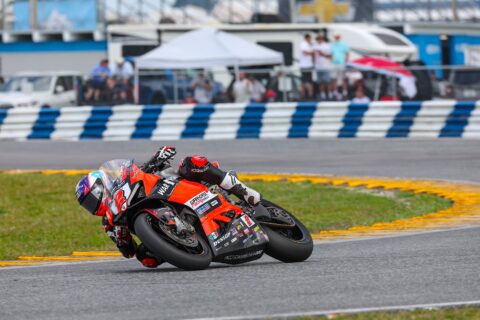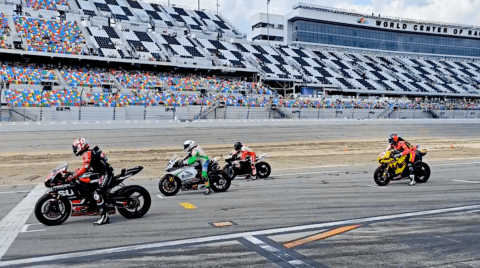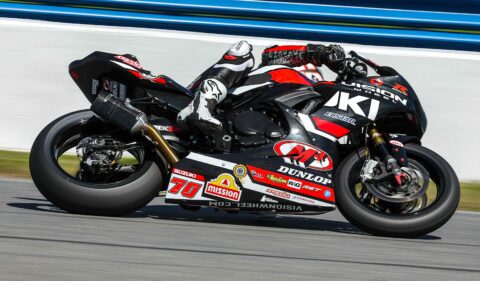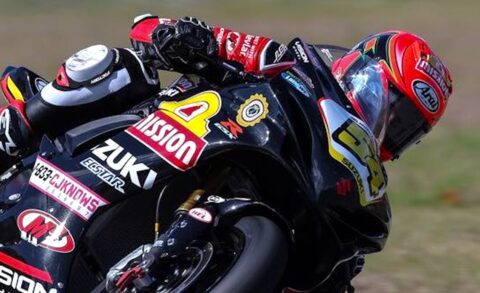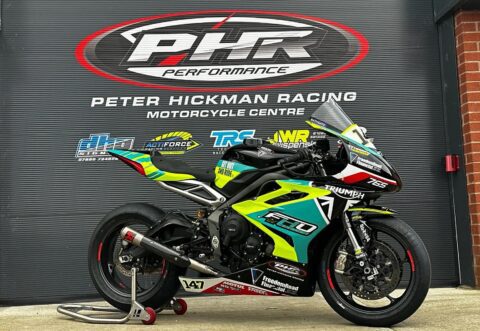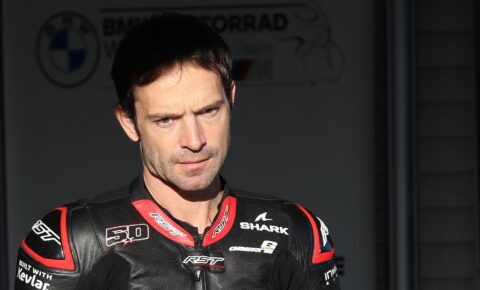They called Bob Dylan a traitor when he first went electric, 55 years ago. His hardcore folk fans were perfectly happy with the acoustic sounds of their hero. Why would you want to mess about with pickup coils and volume dials? Just play the damn music, man.
Like the young Robert Zimmerman, Aprilia stuck with ‘acoustic’ mechanical units in terms of its superbike suspension up till now. But with a set of electric forks and shock on the RSV4 1100 Factory for 2020, will Noale’s hardcore fans be shouting ‘Judas’? Why mess about with solenoids and IMUs? Just ride the damn bike, man.
You can see why a race-focussed outfit like Aprilia might hang back when it comes to this change. By its nature, electronic ‘semi-active’ suspension should be more useful on changeable road surfaces rather than the smooth (in theory…) asphalt on a race track. Add in the fact that the first thing a race team tosses in the skip is the roadbike suspension, and you can see the argument for mechanical, clicker-adjustable suspension on serious race-rep superbikes. Indeed, BMW’s just-announced M1000RR WSBK homologation special superbike has some fairly standard suspension units in comparison to its carbon wheels, titanium conrods and aerodynamic wings. Ditto Ducati’s megabucks Panigale V4R – posh Öhlins kit of course, but resolutely non-electronic.
On the other hand, in today’s battle of the spec sheets, missing out this flashy piece of modern tech might look a little slack, perhaps costing a sale here and there. The purity of the true track fan is all well and good, but we’re also here to make a buck, man.
Aprilia set out its stall very clearly when it launched the RSV4 1100 in 2019 actually, saying that it would only bolt on the electronic suspension package when it helped lap times. And now, for 2020, its engineers reckon that time has come. So now, we finally get a full set of Öhlins Smart EC2.0 semi-active forks, shock and steering damper, integrated into the RSV4’s excellent full colour LCD dash and cunning ECU brain.
It’s actually a little ironic that they made us wait for this though. The firm’s supernaked Tuono got Öhlins semi-active suspension kit last year, and Aprilia was at the forefront with electronic rider aids back in the early 2010s. Its APRC suite of traction control, smart ABS, wheelie control and launch control was one of the first available – and still one of the best to use.
That’s the basic sketch for Aprilia’s 2020 RSV4 superbike then. And now, here I am, in a pit garage at Vallelunga, looking at a brace of slick-shod bikes sat on stands with warmers on. I’ve flown out of a ghostly Heathrow to Rome, on a half-empty BA flight with my mask-clad compadres to get here. Aprilia’s holding a ‘Racer Days’ customer trackday, so the PR dept popped some RSV4s in the truck, and invited us along for a late summer wazz to see how they go.
2020’s been a bit light in terms of continental bike launches on track, so I was well up for it – especially when I remembered what a ball I had on the 2019 bike at the launch in Mugello last year. But it looks like we might as well have not bothered. The heavens have opened, and it’s properly, properly chucking it down. Miniature lakes are forming along pit lane, customers who’ve all turned up for the Aprilia Racer Days event are looking proper cheesed off, and the poor Aprilia factory techs are going through the motions to pass the time: checking the tyre warmers, giving the fairings another polish, topping off the fuel tanks.
Luckily, our hosts are on the ball. Several phone calls find some Dunlop rain rubber at a local dealer, and within the hour we have some mega-treaded, super-soft hoops cooking away under the warmers. I’ve ridden on proper wets a few times in the past couple of years, and always been amazed at how well they work, so the day most definitely looks back on.
There’s a bit of a break in the rain, and so I head out for a quick look round the circuit. I’ve never been here before, so want to see which way it goes, and get a feel for how much grip there is. Weirdly, and not a lot is the answer. This is a track of two halves – the first part is nice and normal, with a big old main straight, couple of fast kinks and a lovely big banked horseshoe bend. One more big kinked straight and another 180 degree turn, then it all turns a bit pony. It’s like someone plonked a go-kart track in the infield, with two super-slow hairpins, one almost needing a dip of the clutch in first gear to get round. Add in polished patches of tarmac from car racing, and you have a stressy, nervous mid-lap, before you come to the nice, normal final turn and onto the main straight again.
A fiddly layout then – and it could be a proper nightmare on the wrong bike. I’ve ridden a few bad-tempered superbikes down the years which would have rebelled badly here, but the new RSV4 is behaving very well indeed. There’s 217bhp tucked away inside that compact 65° V-four motor, but it’s produced in a super-civilised fashion. The throttle control is impeccable, with progressive delivery and easy modulation. Tip-toeing around the drenched track, learning the layout and finding the tricksy polished asphalt repairs is just as easy as it would be on something like an old CBR600RR. Then, when you get it upright and pile on the coals, all the angry grunt you could want is unleashed, catapulting you down the next straight. The quickshifter is excellent both up- and down-shifting, and the change itself is snickety-slick.
The chassis is doing great work too. The RSV4 has always been a big favourite on track, with its super-agile chassis and strong Brembo brakes. The Aprilia techs have programmed in appropriate traction and ABS settings for the wet tyres, and tweaked the electronic suspension to match. It gives a really forgiving ride, with a softer feel front and back. Yet it still feels accurate, taut and precise.
When I get out for the next session, I’ve got the track layout just about nailed in my head, and while I’m still appalled by the crappy infield section, I’m having a ball on the ‘proper’ bits. A bit of a dry line seems to be appearing, so I push a little bit harder on the brakes and the throttle, and start chuckling inside my Arai. There’s nothing to match the Aprilia and Ducati 1100cc superbikes for sheer adrenaline on track, and you really do feel like you’re getting a bit of an insight into what the proper racebikes of a few years back must have felt like. More than 215bhp was the preserve of factory superbikes not so long ago, and to have it in a compact, sub-200kg package is an incredible thing.
Flags out again, and I’m back in for a drink and a break, before heading out for my last session of the day. The weather’s definitely breaking, with patches of blue sky, and I can’t wait to have a proper go. Out of pitlane, down the main straight, and that immense drive rockets the RSV4 towards turn four and five. Hard on the Brembo Stylema brakes, which are working brilliantly despite being soaked and chilled, the back end wiggles a little, and we’re turned and round and out. Down the fastest straight, snicking up to fifth gear before hammering on the anchors again. Hold my breath through the horrid infield and back out, down the main straight and repeat.
I get a few more repeats, getting quicker and quicker, before it all goes a bit wrong. I push just a little too hard on the drying track, lose the back end on the second-gear turn seven, and gracefully slide into the gravel. It’s an innocuous drop from my point of view – my Alpinestars airbag doesn’t even go off – but the poor RSV digs into the gravel, flips over, and ends up looking a bit sorry for itself. Gah. I’m treated to the recovery trailer ride of shame back to the pits, where I make my abject apologies to the Aprilia staff…
So – not the ideal introduction to the 2020 RSV4 1100 Factory. But when I wasn’t falling off the thing or tiptoeing through standing water, I was seriously impressed by it. The electronic suspension puts the 1100 on par with the other flagship superbikes in terms of spec panel bragging, and will also be a boon on the road. Öhlins’ intuitive manual mode settings makes it super easy to tweak for track use too, and with no weight penalty from the kit, it’s a no-brainer. The engine is the same utter weapon it was at the launch in 2019, and those cheeky extra CC really make it stand out from the 999cc machinery in terms of pure stomp. Looking for a proper rider’s superbike for 2021? We reckon even Dylan would love one of these.
TECH HIGHLIGHTS
Engine
Aprilia plumped for a cunningly compact 65° V-four back in 2008, and has since developed it into a proper classic superbike motor. This latest version has a 1,077cc capacity, thanks to the 3mm overbore it gained for last year in the RSV4. That put it on par with the supernaked Tuono in terms of capacity, but the superbike motor gets an extra set of injectors, more compression and higher revs, giving a beefy 217bhp at 13,200rpm. Nice.
Frame
Like BMW’s S1000RR M version, Aprilia’s given its superbike a fully-adjustable twin-spar cast aluminium frame, with adjustable steering head geometry, engine mount position and swingarm pivot point. Pointless for 99 per cent of riders, but a saucy feature nonetheless.
Suspension
The 2019 bike looked a bit bereft on the tech front with its mechanical ‘clickers and C-spanner’ suspension, albeit it in properly lush Öhlins TTX and NIX form. Especially when the competition – Ducati’s Panigale V4S, Yamaha R1M and Honda Fireblade – all use Smart EC 2.0 Öhlins kit, with its semi-active and manual functions, simple adjustment and clear, goal-oriented adjustment menus. Aprilia had claimed it wouldn’t fit semi-active suspension to the RSV4 until it could prove it improved lap times – and now it does. You have three semi-active ‘A’ modes, including a ‘slick’ mode and three manual ‘M’ presets available to click through on the fly.
Swingarm
Saucy double-braced aluminium swinger will look ace grafted onto a brown-seated Bandit 1200 café racer in a few years’ time.
Brakes
Brembo Stylema calipers with radial master cylinder and dinner-plate-sized 330mm discs up front, plus Bosch cornering ABS as part of the APRC rider aids suite. Carbon ram-air cooling ducts are a £257 option and essential for the cred we reckon.
Electronics
Fair play to Aprilia – its engineers got in early with the electronic rider aids shizzle, and they’ve now got a very impressive, accessible system. There are no updates for 2020 apart from the integration of the electronic suspension control, but that’s certainly no bad thing. Traction, ABS, engine braking, power modes, launch control, pit limiter, cruise control, wheelie control – it’s all here, and easily fettled with the mini-joystick and alloy +/- flippy levers.
Aerodynamics
The carbon fibre wings give a claimed 8kg of downforce at 300kph, to help with high-speed stability and braking.
Price: £22,399
Engine: DOHC 16v, 65° V-four, l/c, 1,078cc
Bore x stroke: 81x52.3mm
Compression ratio: 13.6:1
Carburation: four 48mm Marelli throttle bodies, eight injectors, ride-by-wire
Max power (claimed) 217hp@13,200rpm
Max torque (claimed) 89ft lb@11,000rpm
Transmission: six speed cassette gearbox, wet slipper clutch, chain drive
Frame: composite aluminium twin-beam. Swingarm pivot point, steering head/rake and engine mounts all adjustable
Front suspension: 43mm USD Öhlins fork, Smart EC2.0 semi-active control
Rear suspension: aluminium braced swingarm, Öhlins monoshock with Smart EC2.0 semi-active control
Brakes: twin 330mm discs, four-piston Brembo Stylema radial calipers (front), 220mm disc, twin-piston caliper (rear), cornering ABS.
Wheels/tyres: machined forged aluminium)/Pirelli Supercorsa SC1, 120/70 17 front, 200/55 17 rear
Rake/trail: 24.5°/103.8mm
Wheelbase: 1,439mm
Kerb weight : 199kg
Fuel capacity: 18.5 litres
Equipment: APRC (Aprilia Performance Ride Control) IMU-based traction control and cornering ABS, with wheelie control, launch control etc, all individually adjustable, and three pre-set riding modes. Cruise control, TFT colour dash, up/down quickshifter, pitlane speed limiter.

